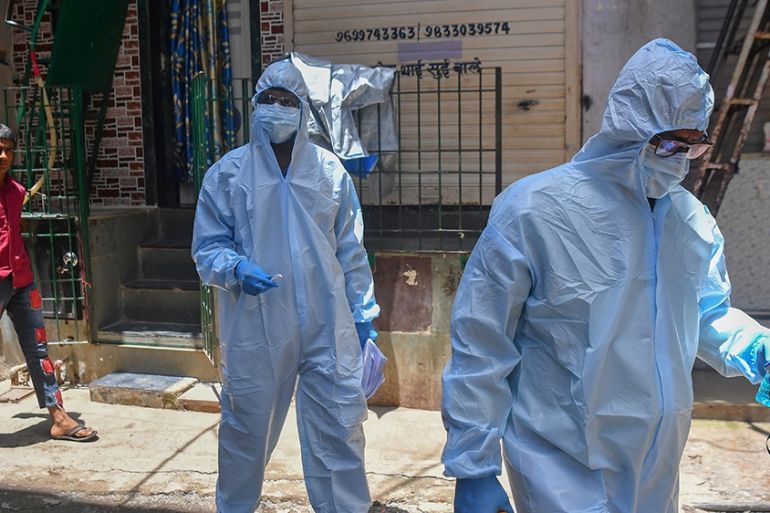‘Chasing the virus’: How India’s largest slum overcame a pandemic
Mumbai’s Dharavi offers a glimmer of hope with new cases shrinking thanks to an aggressive plan adopted by authorities.

When coronavirus claimed its first victim in India’s largest slum in April, many feared the disease would turn its narrow, congested streets into a graveyard, with physical distancing or contact tracing all but impossible.
But three months on, Mumbai’s Dharavi offers a rare glimmer of hope as new infections shrink thanks to an aggressive strategy of “chasing the virus, instead of waiting for disaster”, according to city official Kiran Dighavkar.
Keep reading
list of 4 itemsMexico’s teachers seek relief from pandemic-era spike in school robberies
‘A bad chapter’: Tracing the origins of Ecuador’s rise in gang violence
Why is the US economy so resilient?
The sprawling slum has long been a byword for the financial capital’s bitter income disparities – its estimated one million people eking out a living as factory workers or maids and chauffeurs to Mumbai’s well-heeled residents.
With a dozen people typically sleeping in a single room, and hundreds using the same public toilet, authorities realised early on that standard practices would be of little use.

“Social distancing was never a possibility, home isolation was never an option, and contact tracing was a huge problem with so many people using the same toilet,” Dighavkar told AFP.
An initial plan to conduct door-to-door screenings was abandoned after Mumbai’s searing heat and humidity left medical workers feeling suffocated under layers of protective equipment as they combed the area’s cramped alleys for cases.
But with infections rising fast and fewer than 50,000 people checked for symptoms, officials needed to move quickly and get creative.
What they came up with was coined “Mission Dharavi”.
Each day, medical workers set up a “fever camp” in a different part of the slum, so residents could be screened for symptoms and tested for coronavirus if needed.
Schools, wedding halls and sports complexes were repurposed as quarantine facilities that offered free meals, vitamins and “laughter yoga” sessions.
Strict containment measures were deployed in virus hotspots that were home to 125,000 people, including the use of drones to monitor their movements and alert police, while a huge army of volunteers swung into action, distributing rations so they did not go hungry.
Bollywood stars and business tycoons paid for medical equipment as construction workers built a 200-bed field hospital at breakneck speed in a Dharavi park.
By late June, more than half the slum’s population had been screened for symptoms and approximately 12,000 tested for coronavirus.
So far, Dharavi has reported just 82 deaths – a fraction of Mumbai’s more than 4,500 fatalities.
Brink of victory
“We are on the brink of victory, I feel very proud,” said Abhay Taware, 44, a doctor who saw about 100 patients daily in his tiny clinic at the height of the crisis.
The father-of-two had to fight his own battle against coronavirus when he contracted the disease in April, but told AFP news agency he had “no doubts” about returning to work.
“I thought I could show my patients that a positive diagnosis does not mean the end,” he said.

Although doctors like Taware worked to reassure worried residents, the stigma persists.
After an isolating 25-day spell in hospital and two weeks in quarantine, Sushil – not his real name – said he now feared discrimination if people found out about his diagnosis.
The 24-year-old also struck a note of caution, warning of a potential resurgence in infections.
“People need to take as many precautions as possible. The numbers might have come down, but they can swiftly rise again,” he told AFP news agency.
‘No escape next time’
With Mumbai and Delhi struggling to accommodate coronavirus patients as India’s cases surged past half a million, officials are also wary of celebrating too soon.
“It’s a war. Everything is dynamic,” said Dighavkar.
“Right now, we feel like we are on top of the situation,” he said.
“The challenge will be when factories reopen,” he added, referring to the billion-dollar leather and recycling industries run out of Dharavi’s cramped tenements.
And some in the slum fear their community might not be as lucky next time.
On a blazing hot morning, as car salesman Vinod Kamble lined up to have his temperature taken, he recalled his terror when the virus landed in Mumbai.
“I felt like Dharavi would be destroyed, and nothing would be left,” he told AFP, describing the near impossibility of avoiding infection in the slum.
“We need better infrastructure,” the 32-year-old said.
“Otherwise the next time a disease like this emerges, I don’t think Dharavi will be able to escape.”
|
|